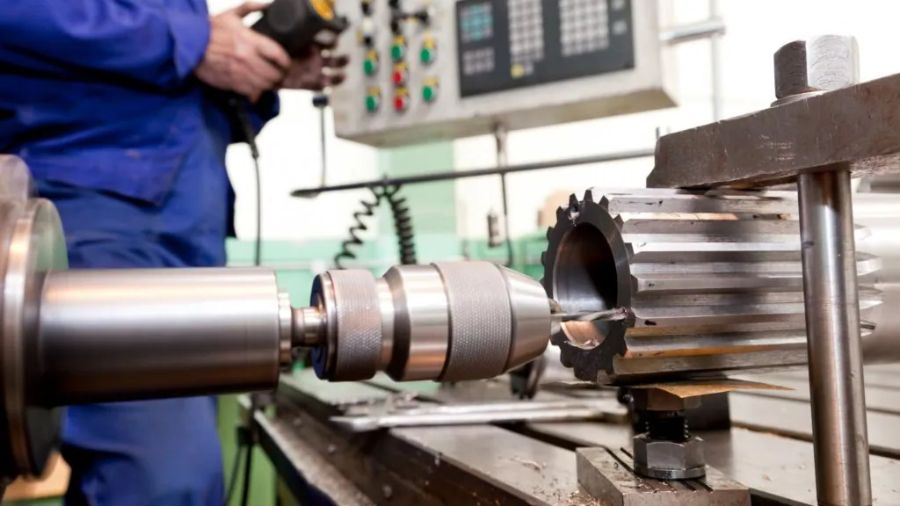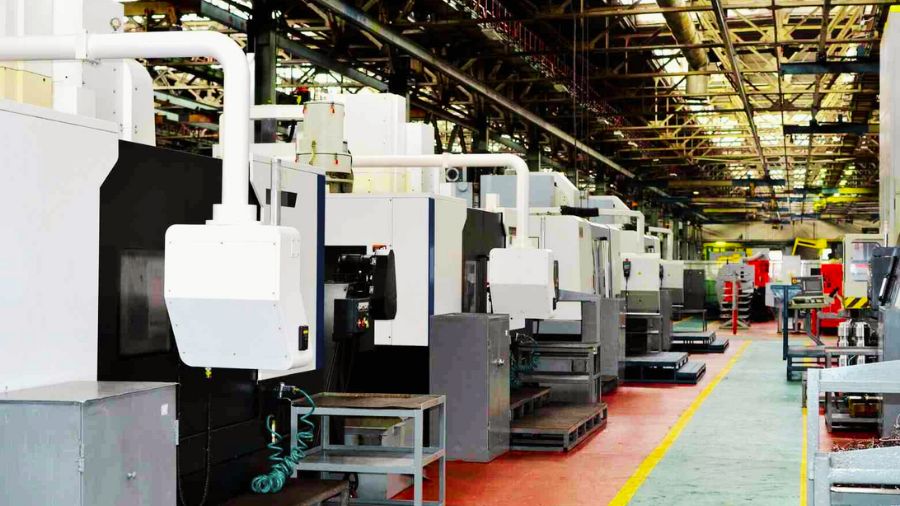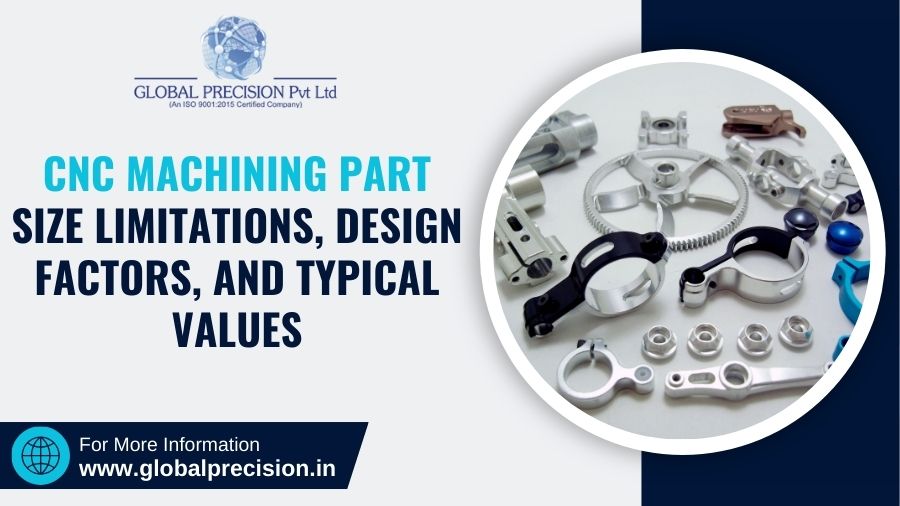CNC machining is the backbone of contemporary manufacturing; it allows engineers and designers to create highly intricate parts with utmost precision. But did you know that every machine has a limit on the size of workpieces and special considerations for design?
Here, we’ll cover the essential information that refers to the part size in CNC machining, including the major limitations, essential design elements, and typical size ranges you can expect: whether this is your first encounter with a CNC Machined Components Manufacturers or you’re drawing up the details for Global Precision Pvt Ltd, this uncomplicated piece will help you make the best choices.
Why Part Size Matters?

Size matters to an extent in every stage of the CNC process.
- Machine Compatibility – Each CNC machine comes with a work envelope that is maximum for it. If the part is too big, it simply will not fit.
- Fixtures and Tooling – Any larger parts that may require custom fixtures or larger tooling will add cost and lead time.
- Material Waste – Oversized stock material will increase scrap rates and the price of the material.
- Accuracy and Stability – Longer/heavier parts are likely to introduce vibration or deflection, compromising accuracy.
Know those size limits upfront to prevent surprises and ensure an easy manufacturing run.
Size That Connects Part To CNC Machining and Production:

The size of the part being machined is perhaps one of the most critical considerations affecting the CNC machining process. Disregarding problems of accuracy and finish, larger parts may actually lie beyond the work envelope of the machine. Small parts, conversely, can be extremely difficult to mount or machine with an accurate definition particularly if tight tolerances are to be achieved. The dimensional CNC machining limits also specifically affect CNC machine choice and the tools borne within.
For instance, CNC milling machines exhibit different work envelopes capable of processing maximum part sizes. With such implications, careful attention to programming designs into the production mode is beyond definition to warrant the parts applied are machined efficiently under desired specifications.
Typical Size Limits For CNC Machines:
While there’s great variation across shops and models, here are some general ballparks –
| Machine Type | Typical Work Envelope (XYZ mm) |
| Small Vertical Mill | 300 × 200 × 200 |
| Medium Vertical CNC | 800 × 500 × 500 |
| Large Gantry CNC Mill | 3,000 × 2,000 × 1,000 |
| CNC Lathe (Max Swing × Length) | Ø 400 × 1,000 |
| Heavy-Duty CNC Turning Center | Ø 1,000 × 2,000 |
- Vertical mills are quite common in most workshops and can handle medium to small-sized components.
- Gantry mills and large bed types can accommodate very large workpieces.
- Lathes are for round parts and generally dimensions are reported as ‘swing’- maximum diameter and ‘length’- distance between centers.
While you talk with a CNC Components Manufacturer, be sure to ask about their specific machine types and capacities.
Limitations To Be Considered
Although XYZ encompasses design space, several physical limitations might go against the design, such as –
- Tool Reach and Rigidity – Long-reach tools may become more prone to flexing, leading to chatter and reduced accuracy. If your part is deep or slender, you may require specialized tools or a multi-axis set-up.
- Workholding Constraints – Complex shapes or large flat areas could need custom fixtures, vacuum tables, or even multi-station jigs.
- Weight and Center of Gravity – Very heavy parts can damage axes or spindles in the machine. Some shops put a maximum weight limit for any part (500 kg is one example) to protect their equipment.
- Axis Travel vs. Table Size – The table-size limits flat parts, but axis travel limits how far the cutting head can move.
- Machine Access – Even if it technically fits, you need ample clearance for tool insertion, probing, and chip removal.
A good CNC Machined Components Manufacturer will evaluate your 3D model and point out any potential clashes or hold issues.
Design Factors For Optimal Sizing
The factors below relate to the design for ease and economy in machining –
a. Avoid Overbuilding Envelope – Do not give your work extra envelope space just in case. Save only for the actual dimensions of the function.
b. Keep Deep Cavities to a Minimum – Deep cores demand long tools, thus strengthening is compromised. Instead, wherever possible: split deep pockets into shallow pockets or use boring heads with side-cutters.
c. Provide for Simplified Fixturing – Design flat faces, or locating features, so that a machinist can quickly locate and clamp the part. Adding three or more orthogonal datum planes is beneficial.
d. Consider Modular Assembly – In the case of large assemblies, some designs can be divided into smaller bolt-together modules. This way, each module stays within standard machine envelopes.
e. Mind the Orientation of Part – Try to orient the part such that critical tolerances are machined in one setup. This keeps multiple setups from adding to fixture costs and risk of alignment errors.
When you deal with a top CNC Components Manufacturer, they would propose tweaks in your CAD model that will maximize the result.
CNC Turned Components vs. CNC Milling Components:
Depending on your geometry, you might select turning, milling, or a combination –
- CNC Turned Components – These are suited for round parts: shafts, bushings, and pulleys. Typical size range: Ø 5 mm to Ø 1,000 mm; lengths up to 2,000 mm. Fast cycle times for simple features.
- CNC Milling Components – Perfect for prismatic shapes, pockets, and contours. Typical work envelope as shown in section 2. Handles way more complex 3D surfaces.
Some shops including Global Precision Pvt Ltd. offer multi‐axis turning centers with live tooling-ideal for parts requiring turning and milling in a single set-up.
Typical Examples Of Part Dimension
The following are some examples of common parts with their corresponding usual size brackets –
Automotive Sensor Housings
- Process – 3‐axis milling
- Size – 100 × 80 × 40 mm
Industrial Shaft
- Process – CNC turning + grinding
- Size – Ø 50 mm × 300 mm
Hydraulic Block
- Process – 5‐axis milling
- Size – 400 × 200 × 150 mm
Medical Connector
- Process – Swiss-type lathe
- Size – Ø 8 mm × 60 mm
These examples show how part size connects with specific processes and machine types. Always match your design to the optimal process.
How To Choose The Right Partner

When evaluating CNC Machined Components Manufacturers, consider their –
- Machine Park – Do they possess machines with the dimensions and suitability for the material of your part?
- Expertise – Have they manufactured similar parts of this size and complexity?
- Quality Systems – Look for ISO certification and in-process inspection capabilities.
- Turnaround and Capacity – Can they handle your volume from a prototype batch to mass production?
- Communication – Firm feedback about design feasibility can save several weeks of lost time.
A reputable CNC Components Manufacturer will treat your design as a partnership by giving design-for-manufacturing advice and specific quotations.
Conclusion
CNC machined parts comprise not just how well the part fits within a machine, but are also relevant to cost, lead-time, accuracy, and longevity of the parts. Learning about machine envelopes, design best practices, and typical size ranges the game for turning and milling these can bring your project to successful completion. With experienced CNC Machined Components Manufacturers or versatile CNC Components Manufacturers like Global Precision Pvt Ltd, your designs can be turned into parts more quickly and efficiently.




